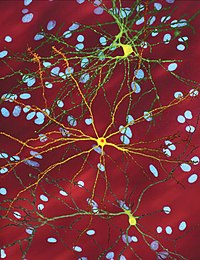
Photo from wikipedia
An increasing number of the population all around the world suffer from age-associated neurodegenerative diseases including Parkinson’s disease (PD). This disorder presents different signs of genetic, epigenetic and environmental origin,… Click to show full abstract
An increasing number of the population all around the world suffer from age-associated neurodegenerative diseases including Parkinson’s disease (PD). This disorder presents different signs of genetic, epigenetic and environmental origin, and molecular, cellular and intracellular dysfunction. At the molecular level, α-synuclein (αSyn) was identified as the principal molecule constituting the Lewy bodies (LB). The gut microbiota participates in the pathogenesis of PD and may contribute to the loss of dopaminergic neurons through mitochondrial dysfunction. The most important pathogenetic link is an imbalance of Ca2+ ions, which is associated with redox imbalance in the cells and increased generation of reactive oxygen species (ROS). In this review, genetic, epigenetic and environmental factors that cause these disorders and their cause-and-effect relationships are considered. As a constituent of environmental factors, the example of organophosphates (OPs) is also reviewed. The role of endothelial damage in the pathogenesis of PD is discussed, and a ‘triple hit hypothesis’ is proposed as a modification of Braak’s dual hit one. In the absence of effective therapies for neurodegenerative diseases, more and more evidence is emerging about the positive impact of nutritional structure and healthy lifestyle on the state of blood vessels and the risk of developing these diseases.
Journal Title: International Journal of Molecular Sciences
Year Published: 2022
Link to full text (if available)
Share on Social Media: Sign Up to like & get
recommendations!